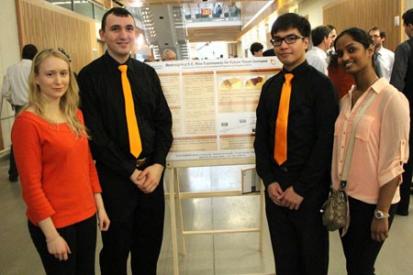
The section of the E.C. Row Expressway between Dougall and Walker roads is arguably one of the most dangerous strips of highway in the region, and many believe it’s only going to get worse as traffic increases in the area.
However, a group of fourth-year civil and environmental engineering students have come up with some designs suggestions to ease traffic that’s expected to double in the area by 2031.
Using the middle median space between the east and westbound lanes to create two additional lanes, or adding an express lane on each side – separated by barriers from the collector lanes – are the two alternatives proposed by Barbara Wlodarczyk, Kaveera Naraynsingh, Terence Dimatulac, and Vincent Colussi.
“I drive that area every day and it’s one of the worst,” said Wlodarczyk, who noted that the projected per-lane, per-hour flow rate just in the area east of Howard Avenue is expected to jump to 5,114 vehicles, far exceeding the existing congestion capacity of 2,300 cars. “It’s crazy there.”
“I see people get cut off all the time there,” added Colussi.
The students formed just one of dozens of teams who displayed their capstone projects in the lobby of the Ed Lumley Centre for Engineering Innovation on Friday. Capstone projects provide students with the opportunity to call upon the wealth of knowledge they’ve gained over four years in their programs and apply it to solving real-world problems.
Many projects were based on community concerns and included a variety of solutions ranging from building pedestrian bridges over local highways to redesigning water treatment plants.
“This gets the students out in the field and teaches them about how they have to handle themselves after they graduate,” said professor Tirupati Bolisetti. “And most of these projects have practical ideas about how to make our community a better place.”
Two teams of students came up with designs for installing roundabouts: one at the corner of County Road 22 and I.C. Roy Drive in Belle River, the other at the corner of Lauzon Parkway and County Road 42.
“This intersection needs traffic calming and a roundabout would be a perfect solution,” said Prochhpal Singh Sra, a student who worked on the latter of the two designs, and noted that at peak hours, as many as 800 eastbound trucks turn left from Lauzon on the County Road 42. “There are huge delays there.”
With the help of an industrial partner at Stantec Engineering, Tyler Nantais, Drew Chevalier, Peter Ponikowski and Morgan Klaas are designing a new drinking water treatment plant for Harrow and Colchester. The current plant is almost at capacity and has to deal with the extra burden of thousands of cottagers coming to the area every summer, Chevalier said.
“The present plant was designed for only 8,000 people back in 1975,” he said.
Designing a new facility has been an enlightening project, according to Ponikowski.
“You really learn a lot about how much hard work is involved,” he said.

Tyler Nantais, Drew Chevalier, Peter Ponikowski and Morgan Klaas pose with their Harrow-Colchester drinking water treatment plant design poster.
